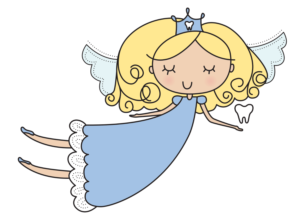The Origins of the Tooth Fairy and Other Traditions

In the UK we have the tooth fairy and the general perception is of a Tinkerbell like figure.
The idea of a tooth fairy can be a great device for children who are anxious or upset about losing a tooth and all cultures seem to have traditions and myths around children losing their baby teeth.
In Asian culture the child is encouraged to throw teeth from the lower jaw up onto a roof and from the upper jaw under the floor whilst shouting a request for it to be replaced by that of a mouse, a reference to the strength of a rodent’s teeth.
In India baby teeth are buried near a big tree and in the Middle East it is tradition to throw them up towards the sun or Allah.
These traditions have been around for hundreds of years. In the Middle Ages the custom was to burn baby teeth in the belief that it would protect the child in the afterlife. Whilst in Medieval Europe burning them would prevent them falling into the hands of witches which could give them control over the child. The Vikings paid children for the teeth as they were considered to bring luck and protection in battle.
In the UK we have the tooth fairy, although it would appear that she originates from the USA. She (or he) is a relatively new arrival to our folklore. There is an early reference to the tooth fairy in the Household Tips section of a a 1908 edition of the Chicago Tribune.
The idea is that when a child loses a baby tooth it is popped under the child’s pillow at bedtime for the fairy to collect and leave a shiny coin in its place.
What form the this fairy takes or looks like differs greatly between people. A study back in 1984 found that 74% of people thought the fairy was female, 12% thought neither male or female and 8% thought either male or female.
The general perception is of a Tinkerbell like figure; but over the years children’s books have portrayed her as a child with wings, a pixie, a dragon, a mother figure, ballerina, two old men, a bat, a bear and a dental hygienist!
In France and many Spanish or Hispanic cultures the tooth fairy takes the form of a mouse known as ‘La Petite Souris’ or ‘Ratoncito Pérez’ respectively.

The tooth fairy concept can be very useful in encouraging good oral care in children.
However you choose to view this mythical creature the concept can be very useful in encouraging good oral care in children. Some parents and carers choose to tell their children that they will receive more money for a perfect tooth and less for a decayed one. It can also be a good motivator to leave a note from the tooth fairy praising the child for good dental habits.
So, what is the going rate for a tooth these days?
A recent survey by VoucherCodesPro found parents in the North West to be the most generous with an average payout of £6 per tooth, in the West Midlands we kept it real with the lowest figure of 50p, but our neighbours in the East Midlands were more generous with an average of £2.30. Amongst others were Northern Ireland 80p, Scotland £1, Wales £4 and South West England £3.70.
At Smile Concepts we have a range of monthly membership schemes designed to take care of the oral health of the whole family. Adult plans start at £16.59 per month and we offer a discount on family memberships. Contact our reception team for more details on 0121 705 2705.

